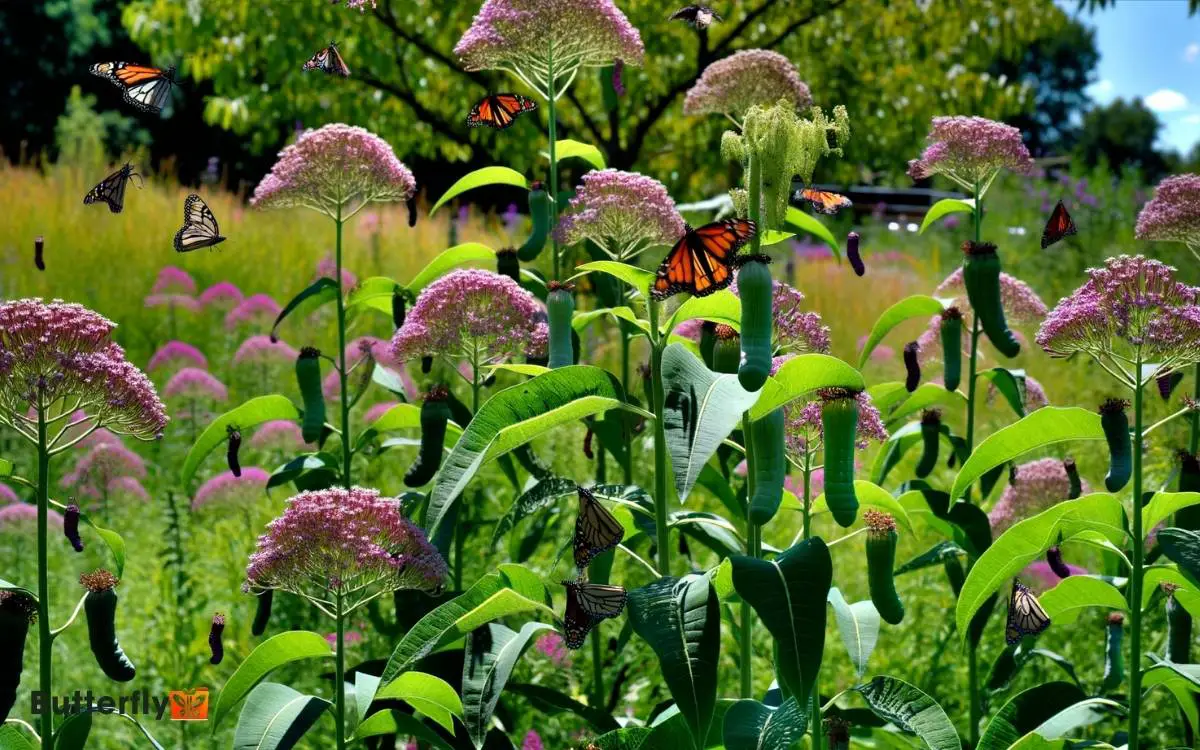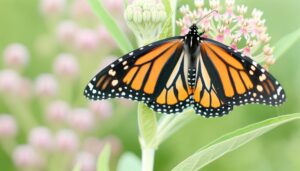Host Plants for Monarch Butterflies: Providing Essentials!
To support monarch butterflies, you should plant milkweed species. Monarch larvae feed exclusively on plants like Common Milkweed (Asclepias syriaca), Swamp Milkweed (Asclepias incarnata), and Butterfly Weed (Asclepias tuberosa).
These plants provide essential nutrients and cardiac glycosides that larvae need for growth and defense.
Tropical Milkweed (Asclepias curassavica) is also beneficial but may disrupt migration patterns. Observations indicate higher survival rates for larvae on these specific species due to the chemical defenses they offer.
By choosing the right milkweed, you contribute to healthier monarch populations and ecosystems. For detailed planting tips and species-specific benefits, explore further.

Key Takeaways
Importance of Host Plants
Host plants play an essential role in the lifecycle of monarch butterflies, providing the necessary nutrients for their larvae to develop and thrive.
You’ll find that monarch larvae, or caterpillars, exclusively feed on specific host plants, primarily those within the Asclepiadaceae family. This dietary specialization means that the presence of these plants directly influences monarch population dynamics.
Without host plants, larvae can’t obtain the cardiac glycosides they need to become toxic to predators, a critical defense mechanism. Observational studies confirm that larvae reared on non-host plants exhibit higher mortality rates and reduced growth.
Hence, maintaining and protecting these host plant populations is crucial for the conservation of monarch butterflies, ensuring their larvae have a sustainable environment for growth and development.
Common Milkweed
Common milkweed (Asclepias syriaca) serves as a vital host plant for monarch butterflies, offering the larvae essential nutrients and chemical defenses needed for survival.
You’ll find that this perennial plant, prevalent in fields and roadsides, provides monarch caterpillars with cardenolides chemical compounds that deter predators.
Observations indicate that these larvae specifically consume milkweed leaves, gaining both sustenance and toxicity that safeguards them throughout their life stages.
Common milkweed’s broad leaves and clusters of pinkish flowers also contribute to a hospitable environment, supporting monarch populations during their migratory cycles.
Swamp Milkweed
Swamp milkweed (Asclepias incarnata) thrives in wetland habitats and offers an essential resource for monarch butterflies, providing both nutrients and a natural defense mechanism against predators.
You’ll find that its high moisture tolerance makes it ideal for growth near swamps, marshes, and along riverbanks. Monarch larvae feed on its leaves, which contain cardenolides—chemicals that render the caterpillars toxic to many predators.
This plant’s vibrant pink clusters of flowers not only attract monarchs but also a variety of pollinators, enhancing local biodiversity. Observations indicate that the plant’s fibrous root system stabilizes soil and improves wetland health.
Butterfly Weed
Butterfly weed (Asclepias tuberosa), distinguished by its bright orange flowers, attracts monarch butterflies by providing not only a nectar source but also an essential larval host plant rich in cardenolides.
You’ll notice that monarch caterpillars feed on the leaves, acquiring these toxic compounds as a defense mechanism against predators.
This species thrives in well-drained soils and full sun, making it suitable for various habitats, from prairies to gardens.
Observations indicate that butterfly weed supports higher caterpillar survival rates due to its resilience and minimal susceptibility to disease.
Additionally, its deep taproot system enhances drought tolerance, ensuring a steady food supply for larvae even in arid conditions.
Tropical Milkweed
When cultivating Tropical Milkweed, you should consider its rapid growth and low maintenance requirements, which make it an appealing choice for many gardeners.
This plant provides essential nutrients and habitat for Monarchs, promoting their lifecycle.
However, it’s important to manage its potential to disrupt migratory patterns and host harmful parasites.
Growth and Maintenance Tips
To successfully cultivate tropical milkweed (Asclepias curassavica), make sure you plant it in well-draining soil with access to full sunlight for the best growth and vigorous flowering. Water the plants regularly, but avoid waterlogging, as this can lead to root rot.
Tropical milkweed thrives in USDA zones 8-11 and may require mulching to retain soil moisture during hot periods. Prune the plants periodically to encourage bushier growth and remove any diseased or damaged foliage.
Here are some key growth and maintenance tips:
| Tip | Details |
|---|---|
| Soil | Well-draining |
| Sunlight | Full sunlight |
| Watering | Regular, avoid waterlogging |
| Pruning | Encourages bushier growth, remove damaged foliage |
Benefits for Monarchs
Providing an essential habitat for monarch butterflies, tropical milkweed (Asclepias curassavica) offers both a larval food source and a site for adult oviposition, fostering their lifecycle and migration.
You’ll observe that monarch caterpillars exclusively feed on milkweed leaves, which contain cardenolides compounds that render them toxic to predators.
Additionally, adult monarchs utilize the vibrant flowers of tropical milkweed for nectar, facilitating their energy needs during migration.
Research has shown that the presence of tropical milkweed can increase local monarch populations by providing continuous nourishment and breeding grounds.
By planting tropical milkweed, you’re directly supporting monarch reproduction, enhancing their chances of survival, and contributing to their remarkable migratory journey.
Your garden becomes an essential stopover for these iconic pollinators.
Potential Drawbacks Considerations
Despite its benefits, tropical milkweed can pose certain ecological risks that you should consider before incorporating it into your garden.
This species can disrupt the natural migration patterns of monarch butterflies, causing them to overwinter in areas where they wouldn’t normally.
Additionally, it can facilitate the proliferation of the parasite Ophryocystis elektroscirrha (OE), a pathogen detrimental to monarch health. Research has shown that continuous availability of tropical milkweed can lead to higher OE spore loads on monarchs.
Furthermore, tropical milkweed may outcompete native milkweed species, reducing biodiversity.
To mitigate these risks, you should periodically cut back tropical milkweed to encourage migration and consider planting native milkweed species that are better adapted to local ecosystems.
Narrowleaf Milkweed
When you plant Narrowleaf Milkweed (Asclepias fascicularis), you’re providing a critical resource for monarch butterflies and their larvae.
This species thrives in well-drained soil and full sun, making it an excellent choice for a variety of landscapes.
Monarchs are particularly drawn to its narrow leaves and clusters of white to pale pink flowers, which offer essential nutrients for their lifecycle.
Ideal Growing Conditions
Narrowleaf milkweed thrives in well-drained soils and sunny locations, making it ideal for supporting monarch butterfly populations.
To optimize growth and guarantee robust plants, you should consider the following conditions:
- Soil pH: Maintain a slightly acidic to neutral pH range of 6.0-7.0. This promotes nutrient availability and healthy root development.
- Watering: Water moderately, making sure the soil remains moist but not waterlogged. Overwatering can lead to root rot.
- Sunlight: Provide full sun exposure, at least 6 hours of direct sunlight daily. This encourages vigorous growth and flowering.
- Temperature: Ideal growth occurs in temperatures ranging from 65-85°F (18-29°C). Extreme temperatures can hinder development and flowering.
Monarch Attraction Benefits
By cultivating narrowleaf milkweed under these ideal conditions, you can greatly enhance its ability to attract and sustain monarch butterflies, providing them with essential resources for their lifecycle.
Narrowleaf milkweed (Asclepias fascicularis) is rich in cardenolides, chemical compounds crucial for monarch caterpillars’ defense against predators.
The plant’s dense clusters of flowers produce copious nectar, a critical energy source for adult monarchs during migration.
Observations indicate that monarchs preferentially oviposit on narrowleaf milkweed, ensuring larvae have immediate access to food upon hatching.
The plant’s adaptability to various soil types and its drought tolerance make it a resilient choice for diverse environments.
Showy Milkweed
Showy Milkweed (Asclepias speciosa) serves as a critical larval food source for Monarch butterflies, offering both nourishment and habitat. You’ll find its broad leaves and pinkish clusters highly attractive to Monarchs.
Here are four reasons why you should consider cultivating Showy Milkweed:
- Nutrient-Rich Leaves: The foliage provides essential nutrients for Monarch caterpillars, ensuring robust growth and development.
- Toxic Protection: The plant contains cardenolides, which make the larvae distasteful to predators.
- Habitat Provision: Its dense structure offers refuge from environmental stressors.
- Pollinator Support: In addition to Monarchs, Showy Milkweed attracts a variety of pollinators, enhancing local biodiversity.
Whorled Milkweed
You’ll find Whorled Milkweed (Asclepias verticillata) easily identifiable by its slender leaves arranged in whorls around the stem.
This species exhibits resilience in various soil types and full sun, making it ideal for diverse habitats. Proper care involves minimal watering and ensuring well-drained soil to prevent root rot.
Identification and Characteristics
Whorled milkweed (Asclepias verticillata) is easily identifiable by its slender, needle-like leaves arranged in whorls around the stem.
You’ll notice it stands out due to its unique characteristics:
- Leaf Arrangement: The leaves form in groups of three to six, creating a whorled pattern that’s unmistakable.
- Flower Structure: Tiny, white flowers cluster together in umbels, typically blooming from June to September.
- Height: This species usually grows between 1 to 3 feet tall, making it relatively small compared to other milkweeds.
- Habitat: Found in prairies, open woods, and roadsides, it thrives in dry, sandy soils.
These features make whorled milkweed a distinctive and essential host plant for monarch butterflies.
Growth and Care
To successfully cultivate whorled milkweed, make sure you’re providing well-draining, sandy soil that mimics its natural habitat. This perennial prefers full sunlight, requiring at least six hours of direct light daily.
Plant seeds in early spring for best germination. Water sparingly; overwatering can lead to root rot. Whorled milkweed exhibits drought tolerance, thriving in dry conditions once established.
Regular pruning can manage its growth and encourage denser foliage. Monitoring for pests like aphids is important, as they can damage the plant. Employing neem oil can effectively control infestations.
With proper care, your whorled milkweed won’t only flourish but also attract monarch butterflies, offering them an essential food source during their lifecycle.
Poke Milkweed
Occasionally found in shaded woodland areas, Poke Milkweed (Asclepias exaltata) provides a critical habitat and food source for monarch butterfly larvae.
This perennial herb thrives in partial shade, offering unique advantages for monarchs. You’ll notice its tall, slender stalks and white to pinkish flowers, which attract not only butterflies but other pollinators as well.
Poke Milkweed’s specific attributes include:
- Habitat Preference: Prefers moist, shaded environments, often found in forest understories.
- Larval Host: Monarch larvae feed on its leaves, gaining essential nutrients and chemical defenses.
- Pollinator Magnet: Its flowers produce nectar that supports a variety of pollinators.
- Growth Pattern: Reaches heights of 2-6 feet, making it a substantial presence in woodland ecosystems.
Understanding these attributes helps guarantee monarch conservation efforts are grounded in ecological accuracy.
Planting Tips
When planting milkweed for monarchs, make sure to select species native to your region to maximize ecological compatibility and monarch survival rates. Plant milkweed in a sunny location, as monarchs thrive in direct sunlight.
Space plants 1-2 feet apart to guarantee proper growth and airflow, reducing disease risk. Water regularly but avoid waterlogging.
| Planting Aspect | Tips |
|---|---|
| Soil Type | Use well-draining soil to prevent root rot. |
| Companion Plants | Include nectar plants like lantana and zinnias. |
| Maintenance | Remove aphids manually to protect milkweed health. |
Monitor for pests like aphids and use organic methods for control. Mulch around the base to retain moisture and suppress weeds. This approach secures a thriving habitat for monarchs.
Conclusion
To sum up, by planting these diverse milkweed species, you’re basically rolling out the red carpet for monarch butterflies. Each variety serves as a crucial proof, providing the necessary nutrients for larvae to thrive.
Observations show that a mix of milkweeds can greatly boost monarch populations. So, dig in, get your hands dirty, and create a haven that supports these delicate yet resilient creatures.
Your efforts will lead to a fluttering demonstration of nature’s intricate balance.






